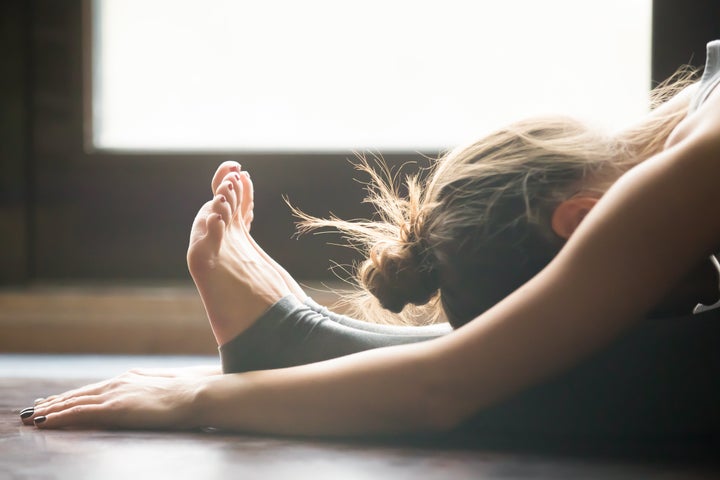
You’re reading Move, the nudge we need to get active, however makes us happiest and healthiest.
People often use workouts to de-stress so it’s easy to be distracted, switched off and on autopilot while you exercise. But if our mind isn’t present, we might not be getting as much out of our workouts as we’d hope.
“Our workout time is a great time to exercise our mindfulness muscle as well as our thighs and glutes,” Chloe Brotheridge, hypnotherapist and author told HuffPost UK. “Life is just better when we’re present. Tuning into your body and your surroundings takes you out of your head and away from your worries and you feel like you’re truly engaged with life.”
We spoke to personal trainers to get their advice on how we can make our workouts more mindful.
Before your workout
Being mindful while you work out starts before your workout has begun. Rather than rush into your run or HIIT class, think about how your body is feeling.
“Scan your body before you start,” advised Jessica Stewart, master trainer at Centric:3Tribes. “Do you need to move to generate energy and combat fatigue or do you need to stabilise and be still to calm and centre?
“Do you have aches or injuries? Asking these questions before ensures you work with the body you got right now and prevent injury... which always happens at the point we lose focus in our practice or push too hard.”
Stewart said it’s good to set a goal before you work out. What do you want to achieve? What are you doing to do? Why are you there?
If your goal is performance, you’ll need a mindset of concentration and focus; if your goal is to let go of stress from your day, you’ll need a gentle mind state and deep breathing to carry you through.
During your workout
Whatever workout you’re doing, breath is so important.
“Breathe deeply,” said Stewart. “The breath has a super powerful ability to ease muscular and mental tension as well as improve your performance.”
Breathing deeply ensures oxygen gets to your muscle fibres, creating energy and reducing fatigue. It also sends signals to the nervous system that you’re relaxed, which increases your tolerance to challenge and enables you to go “deeper into stronger stretch sensations”.

1. Running
To have a mindful run, practise tuning in to the sights, sounds and smells around you.
“Notice the ground underfoot, the smell of the fresh air, the colours of the plants and trees and the feeling of the air going in and out of your lungs,” said Brotheridge. “Many runners talk about getting into a state of flow when they do this where they are totally present, clear headed and feeling fantastic.”
Zoe Toumazos, personal trainer at 1Rebel, said going without music or a fitness tracker will make your cardio workout more mindful.
“The majority of us would automatically put our earphones in, have the music pumping and some sort of tracker to monitor your distance, speed and time,” she said. “With no music or tracker you will take in your surroundings and be more conscious of the way you are using the muscles and body. You may not run or cycle as far or as fast but you’ll feel really content all day.”
2. Yoga
In yoga it can be easy to want to mentally check out rather than be mindful of what you’re doing, especially if it’s an uncomfortable pose.
“If something’s uncomfortable (I’m looking at you, pigeon pose!) our minds can go into overdrive to distract us away from having to ‘feel’,” explained Brotheridge. “Yoga is a great time to be mindful because we can practice being uncomfortable and being ok with it.”
Brotheridge advised people to tune in to every sensation during a yoga class - even the uncomfortable ones - and have an “attitude of acceptance” towards it.

3. Weightlifting
Lifting weights is arguably something that is best done in a slow and deliberate way, rather than rushing without much attention.
Toumazos said when it comes to weightlifting or body weight circuits, really try to take time out to plan your workout and your intention for that session.
“If you take a second to think about your plan of doing 20 kettle bell swings you are more likely to succeed,” she said. “It doesn’t matter how many times your mind drifts, just bring it back to that practice of moving mindfully.”
As you’re lifting weights, you should also focus your body on slowing down, paying attention and appreciating your strength.
“Pay attention to each muscle contracting and relaxing and recognise just how strong and amazing your body is - rather than simply what it looks like,” Brotheridge said.
After your workout
With everyone’s busy schedules, it’s tempting to run straight off into the changing room after a workout. But Toumazos advises to stay for that cool down if you’re in a group class, or give yourself time at the end of your workout to just breathe.
“Remember all the good things about your workout and how it’s made you feel now you’re finished,” she said. “Take a moment to feel the effects of how hard you have worked out and end on a good note.”
Rob Smyth, founder of UN1T London, added: “This is a great way of reflecting on the session you have just finished especially if it is a HIIT or cardio class as these classes are quite intense on your body.
“Mobility is your foundation to training - if your mobility weakens? Your training will suffer.”
Move celebrates exercise in all its forms, with accessible features encouraging you to add movement into your day – because it’s not just good for the body, but the mind, too. We get it: workouts can be a bit of a slog, but there are ways you can move more without dreading it. Whether you love hikes, bike rides, YouTube workouts or hula hoop routines, exercise should be something to enjoy.
